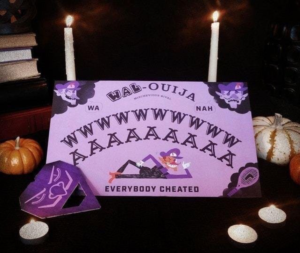Abstract | PDF | Volume 1 (Issue 2) | Request Permissions
Ready Player Four: Waluigi and the Rainbow Road to the Alt-Right
Michael Bodkin
Biography | Notes
Keywords: Waluigi, Nintendo, alt-right, Baudrillard, carnivalesque
The internet has gone purple. Nintendo’s Waluigi, the lanky nemesis hailing from the Marioverse, envenoms the internet in the spread of toxic memes, infinitely looping “crotch-chopping” gifs, to eye-rolling and ironically sentimental (WAH)lentine’s Day cards written in Comic Sans font. From advertising Sham-Wahs to sprawling across Wal-Ouija boards, the spike in popularity of Waluigi proves that Nintendo’s fourth amusement plumber has infiltrated mainstream media quite unlike its classic red and green heroes. These hoodwinking memes seem to carry the nefarious tradition of the similar crimped-moustached and crooked-nosed caricature Dick Dastardly, whose quintessential archetype is known to somehow devilishly foil the world of Yogi Bear and his friends. Similarly, Waluigi sneaks up in popular media but to clown around in mainstream etiquette instead, and interrupt neoliberal divinations and capitalist prophecies. To many reddit and Facebook users uniting under the hashtag #justiceforwaluigi, there is an emergent “Wahmunism” that recognizes the induction of Waluigi as a ‘woke’ anti-hero into the memeverse along with other fictional characters such as Shaggy from Scooby-Doo, Thanos from the Avengers, Shrek, and Kramer from Seinfeld.
Patrick Marlborough, a journalist who writes for Australian online magazine Junkee, discerns Wahmunism throughout many dark corners of the internet: “His persistent nastiness makes him stand out in the Marioverse. The internet is littered with videos of pop-songs as sung by Waluigi, Waluigi edited into other video games, Waluigi fan-films, even Waluigi hentai… The catchphrase ‘It’s Waluigi time’ is ubiquitous on Tumblr. Waluigi revisionism is very real, but ultimately harmless.”[1]
At face-value, #justiceforwaluigi, popularized after Waluigi’s exclusion from Nintendo’s Super Smash Bros. Ultimate, appears only to be an innocuous jamboree of memes as a visual—at times, sentimentally poetic—petition for the avatar to be a playable brawler. Scrolling through these memes might come to a crawling stop when a floating head of Waluigi appears superimposed onto a screenshot of Donald Trump during a presidential debate with the caption “We need to build a wah” (figure 1).

Suddenly, the symbolic function of Waluigi mutates. In another corner of the Internet, Waluigi can be seen shapeshifting into the likeness of an eternally weeping Pepe the Frog, whose popularity stems from Matt Furie’s 2005 comic Boy’s Club (figure 2). As
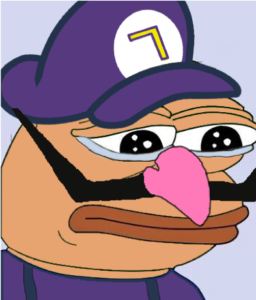
Mike Wendling, author of Alt-Right: From 4chan to the White House observes, Pepe is none other than a “mascot of the alt-right movement” which saw its appropriation into alt-right groups by 2016.[2] Could Nintendo’s seemingly harmless avatar be co-opted by neo-Nazism? Exploring the bait-and-switch of “alt-light”[3] psychology, which according to Wendling may provide insight to Waluigi’s affiliation with Trump and Pepe, and perhaps alt-right sensibility. According to Wendling, the purpose is to slowly “draw people further towards [the alt-right] side.”[4] The self-pitying and misunderstood Mario brother demonstrates a new face of authority in a toxic atmosphere of eccentric right-wing politics, obnoxious memes, and revolutionary platformers that question Marlborough’s claim of “harmless” Waluigi revisionism. The purple haze of Wahmunism as an ideology is an incubator for an alt-light sensibility, and Waluigi stands proudly as its leader.
To show how this inauguration unfolds, I situate Waluigi within a short analysis of Jean Baudrillard’s concept of the epidemic of value to demonstrate how Nintendo’s avatar is an exemplar for the modern condition of the effects of valueless simulation. Rendered as an empty signifier, Waluigi becomes the perfect meme on which layers of “memetic folklore”[5] command Waluigi’s moral leverage. This discussion will dovetail with a brief look at Mikhail Bahktin’s reading of the carnivalesque to provide insight to Waluigi as an inversion of a political left (Mario). I develop these concepts in tandem with Angela Nagle’s examination of alt-right sensibility to situate Waluigi as a potential influencer of alt-light agendas. But before we dive into the theory, this paper turns toward a quick glance of Waluigi’s extraordinary technological heritage.
Since his sudden inception in 2000 as a new contender in Mario Tennis, Nintendo has yet to provide any lore of his belonging in the Mario Brothers series alongside the digital heroes of the 80s and 90s. Neither have they provided a strong interpersonal history of the character to legitimize his belonging to the franchise. The idea of Waluigi was simply born out of a technical flaunting that filled the Nintendo 64’s infrequently used fourth controller, allowing the rare occasion of four players to compete in doubles tennis against each other. It would make sense, as Marlborough states, that “Mario had a decent rival in his stocky garlic-guzzling nemesis Wario, but what of his brother (and doubles partner) Luigi? And so [Fumihide Aoki of Camelot Games] created Waluigi.”[6] Red with green; yellow with purple. The pairing makes some sense in basic colour theory; yet, as he rightly observes, the archetypal matching between Luigi and his rival is blatantly left unfinished. Quite possibly, the fact that Waluigi was cloned ex nihilo out of technological rather than mythological necessity has provided reason for the gaming community to give Waluigi some character development or “folklore,”[7] in Lynne McNeill’s words, onto an otherwise silent and misshapen model. For McNeill, attaching folklore to an instance of internet media is an attempt to linguistically rescue its otherwise fading relevance.
But Waluigi’s lack of narrative within the fantasy realm of the Marioverse has indeed led to stranger interpretations that have engendered him with a questionable sense of eeriness. Take for example, Marlborough’s recitation of a profound ontological analysis of Waluigi beginning with a brief etymology of his name:
[I]n Japanese [it] is Waruīji: ‘warui’ meaning ‘bad’, ‘Luigi’ meaning, well, ‘Luigi’. But it’s also a pun on the Japanese word Ijiwaru, meaning ill-tempered or cruel. Waluigi is nothing but an alternate of Luigi, who is an alternate of Mario—created to be Wario’s (the perversion of Mario) partner in crime.[8]
Aside from piggybacking on the vague familial ties to other characters who already have a story established within the Marioverse, Waluigi’s only ties within the rivalling tennis quartet is through harmless cloning, palette swapping, and a quasi-inversion of protagonist semantics and branding.[9] This recuperation makes some logical sense in terms of creating rivals out of more than the colour of their suspenders. Waluigi also grotesquely differs in likeness and attitude, which has consequentially given the character a doubly negative quality. Marlborough’s analysis continues, but in this instance to address his curious letter-branding: “His design (his cap bares an upside down ‘L’) denotes his role as a signifier created solely to reflect another signifier—a black-mirror, a shadow of a shadow. Waluigi is a triple negative, a man outside himself, a man built to fill a void by functioning as one.”[10] Therefore, Waluigi is a distant derivative of the original formula but separated from it by two other layers of archetypal signifiers which can never be known to the other two brothers. While this mirroring analogy seems dark, Marlborough is perhaps using this cultural folklore to suggest that Waluigi is an isolated character and is branded as such by a doubly inverted symbol that is not read in the English alphabet. This means Waluigi is more easily dissociated from the script of the Marioverse. In other words, the avatar represents the appeal of total freedom and can vacillate between gaming and cultural politics more readily than the other brothers. This might explain the explosion of Waluigi-mania on the internet as the avatar is a magnetic tabula rasa for the absorption of a new cultural code—symbolized by none other than the upside-down L.
It is not surprising that Marlborough’s echoing of Waluigi’s cultural folklore closely follows Baudrillard’s post-structural warning signs of simulation and simulated value, which is reminiscent of his critique of modernity in The Transparency of Evil: Essays on Extreme Phenomena. In an ironic usage of particle physics as a way of lamenting the fate of aesthetics within burgeoning technocratic societies and their biopolitical side-effects, Baudrillard claims that:
[T]he first of these stages had a natural referent, and value developed on the basis of a natural use of the world. The second was founded on a general equivalence, and value developed by reference to a logic of the commodity. The third is governed by a code, and value develops here by reference to a set of models. At the fourth, the fractal (or viral, or radiant) stage of value, there is no point of reference at all, and value radiates in all directions, occupying interstices, without reference to anything whatsoever, by virtue of pure contiguity. At the fractal stage there is no longer any equivalence, whether natural or general.[11]
It is helpful here to briefly contextualize his theory within the interests of this paper, and through the lens of the game’s universe. The first stage of value can be associated with the original idea (Mario) which is then dispersed by consecutive and very close repetitions of the model and inherent value in effort to create companions or family members (Luigi as second; Wario as third). Each brother differs slightly in appearance and outlook but in the case of Waluigi, who represents the fourth or fractal stage of value, this avatar is absolved of referential weight and granted absolute interpretive freedom. This results in what Baudrillard calls the “epidemic of value, a sort of general metastasis of value, a haphazard proliferation and dispersal of value.”[12] Waluigi’s appearance as a nemesis is furthermore compatible with how Baudrillard describes the desire of the fractal. That is, the “secret urge to be rid of their [original] ideas, of their own essences, so as to be able to proliferate everywhere, to transport themselves simultaneously to every point of the compass…A thing which has lost its idea is like the man who has lost its shadow, and it must either fall under the sway of madness or perish.”[13] Waluigi’s iconic “wah,” one of the only sounds we ever hear him speak, represents the cry of the fractal stage, the emotion of the metaphorical descent into madness through endless repetition and valuelessness. In the same analytic swoop, Baudrillard’s transaesthetic theory opens up possibilities to suggest how Waluigi as a digital creation can or might infect many areas of cultural content simultaneously without seeming incongruous or dissonant. In the endless void of simulated images and models, at the very end of the “culture degree Xerox,”[14] the fractal or Waluigi stands as a symbol of simulated liberation. The very notion of an endless simulation serves for Baudrillard as an introduction to talking about transaesthetic theory, or what he colloquially calls “after the orgy”[15] of modern thought. Such orgiastic concepts transform the original inception of a “Mario Party” into an entirely different connotation. Waluigi’s transaesthetic value could only be represented politically as an evil nemesis to thwart the original heroes of the traditional Marioverse and assume the form of an online troll.
As a model of the fractal stage, Waluigi demonstrates a certain permeability through various levels of culture. Gene Park’s illuminating analysis in The Washington Post might contribute to some understanding as to why Waluigi is precisely gaining significant amounts of leverage in the meme world. He states:
[T]hat blank canvas ended up becoming Waluigi’s greatest gift. Since he stood for nothing, supporters could project their wildest hopes unto him, like Barack Obama in 2008 but actually good at golf. He can be described in a single website as anyone from a “true nowhere man” to “the logical end point of capitalism” and the “triumph of capital over creativity.” In other words, Waluigi became the perfect meme fodder.[16]
Park’s analysis begins to unveil that the appeal to Waluigi is partially due to its plasticity. Whereas the explicit meaning of Waluigi within the Marioverse desires to trick Mario, the symptomatic meaning could imply a risk to corporate Nintendo. The idea has been exacerbated in one of Waluigi’s more popular memes, which ironically depicts the avatar standing triumphantly over a cityscape reminiscent of a tyrannical Godzilla with the caption “FUCK CAPITALISM” (figure 3).

Park seems to indicate that those who might choose to play as Waluigi or perhaps photoshop him into the ceaseless production of memes, is an attempt at social and capital destruction. Franck Libery, who contributes to the conspiracy webpage “Critical Perspectives of Waluigi,” extends Park’s review to include a more intimate and therefore more terrifying interpretation:
Waluigi is the true nowhere man, without the other characters he reflects, inverts and parodies he has no reason to exist. Waluigi’s identity only comes from what and who he isn’t—without a wider frame of reference he is nothing. He is not his own man. In a world where our identities are shaped by our warped relationships to brands and commerce we are all Waluigi.[17]
In the eyes of Waluigi, there is an opportunity to vicariously experience a way to question fraught relationships with capitalism and its discontents. Even if Waluigi is rolling on the ground crying or amplified hatred for an economic system, the behaviour that Waluigi embodies—both in-game and online in meme circulation—correlates to triumph. No matter the outcome played out in-game, Waluigi is consistently portrayed as a sore winner. As Marlborough reflects on the evasive politics of right-wing politician Tony Abbott, “[i]f it looks like they are about to lose they threaten to upend the board or rip out the cartridge. To them, winning isn’t enough. You must lose. Hence, victory never satisfies them. They love to fire the blue shell, dodging it is something else entirely.”[18] Waluigi’s elevation into the political sphere may not be farfetched, especially if Nintendo is producing games with overtly juvenile impulses, prepubescent syntax, and yet oddly surreal designs directed towards a younger generation.
When Mike Wendling described the alt-light to be a more “youthful movement”[19] that “values trolling and internet pranks not just as sideshows or light diversions, but as key forms of political action”[20] and “video gaming,”[21] there might exist an uninterrupted interaction between home console or PC gaming, and online video-sharing platforms like YouTube and Vimeo. The switch between video game and online political rant is rather effortless in current console and home computer technology. Whether ripping out a cartridge from the Nintendo, forced rage-quits and hard resets, there may be a correlation between (violent) behaviours in gaming, and the relationship to the production of memes in the form of trolling in a space online as an outlet of victory.
Kate Pahl’s study on the relationship between the formation of childhood identity, particularly in how it appears in interactions with console video games, could provide some explanation to this type of behaviour. Pahl, who incorporates Pierre Bordieu’s concept of habitus into her study, demonstrates how the process of recontextualization occurs cross-textually in the formation of identity “from de-location to re-location of a discourse.”[22] She concludes that there are comparable spaces created in video games that are similar to elements found within everyday life situations that are peripheral but nonetheless pedagogical. “Console games,” she explains in her research, “offer a space in which identity can be linked to agency, and embodied action is possible in ‘as if’ figured worlds. Some [participants] lacked material resources, and yet these games offered ‘a figured world’, which led to textual possibilities.”[23] What is missing from her conclusion is the blending of these worlds as one platform, which can not only confuse ethical perception but also prevent gamers from perceiving the ethical world behind social media platforms in the realization of these textual scripts. The discrepancies or even verisimilitudes between them might be stretching out another space between them in which gamers toy and experiment with political thought. Shifting between both spaces becomes a translational complication and requires spatial acuity.
Gaming seen as an activity performed in solitude, coupled with the explosion of unfiltered online content, nevertheless alludes to Angela Nagle’s commentary on the vacillation between aggressive political activity and extreme isolation. In her book Kill All Normies: Online Culture Wars from 4chan and tumblr to Trump and the Alt-Right, Nagle traces“[t]he Situationists’ critique of ‘the poverty of every day life’, like Baudelaire’s An oasis of horror in a desert of boredom [italics not mine], [which] articulated a common sentiment found from the Romantics through to contemporary online cultures of transgression, that ennui, boredom and inertia requires a counterforce of extreme transgression.”[24] It is no surprise that Waluigi has become the meme that sways between political spaces and gaming environments.
The pace is building momentum. The faster the vacillation between worlds combined with the increasing verisimilitude of digital worlds, the less distinct the line becomes between worlds. This approach helps Nagle consider online transgression with a utopian critique. She approaches her understanding of 4chan culture through an invocation of the carnivalesque, which derives from Mikhail Bakhtin’s theoretical work on utopias and carnival. She refers to his concept of the carnivalesque to help identify notions of “radical transgression against hierarchy and hegemony”[25] to locate “self-descriptions of trolls on what trolling is doing.”[26] In quoting Bakhtin, she states: “[c]arnival laughter is the laughter of all the people. Second, it is universal in scope; it is directed at all and everyone, including the carnival’s participants. The entire world is seen in its droll aspect, in its gay relativity. Third, this laughter is ambivalent; it is gay, triumphant, and at the same time mocking deriding.”[27] Under a Bakhtinian interpretation, Waluigi resembles more of the court-jester or clown in the Kingdom than he does his fellow wrench-holding plumbers, symbolized by both his incessant “wah-ha-ha’s” and the inverted L, a sigil to grant access to turning the world upside-down. Waluigi juxtaposed as an abrasive, political, clownish figure resounds with the alt-right tendency to invert any form of political correctness to “[mirror] that of their sworn enemy, the ‘social justice warriors’”[28] (Mario and Luigi). While they might appear similar in the distorting, a tacit threat lingers in the warped reflection.
Michael Gardiner notes how Bakhtin’s reading of the carnival can indeed be interpreted as a threat but in a way that conveys a “bacteriological metaphor.”[29] In “Utopia as Critique,” Gardiner claims that the “carnival is an ‘antibody’ living within a pathological social body, always threatening to rupture it from within. In other words, carnival is simultaneously continuous with the contemporary social world and desperately at odds with it.”[30] That goes to say, any world, political or not, that Waluigi “crotch-chops” in has an internal, churning, carnivalesque aspect as a gateway to alternative social worldviews. Furthermore, as Gardiner continues, the idea of “[c]arnival…leads men and women out of the ‘apparent (false) unity’ of the epic mentality, out of what is ‘indisputable and stable.’”[31] Carnival, therefore, can be regarded as a powerful catalyst for the proposition of desiring to see drastic change in any context. The carnivalesque element drives Waluigi both digitally and conceptually can mediate an array of alternative voices through which reigning political ideologies can be challenged. Bahktin says this is also expressed as laughter, an entwining symbol of mockery, celebration, and triumph, which for those voices “frees them completely from all religious and ecclesiastic dogmatism, from all mysticism and piety. They are also completely derived of the character of magic and prayer; they do not command nor do they ask for anything. Even more, certain carnival forms parody the Church’s cult. All these forms are systematically placed outside the Church and religiosity. They belong to an entirely different sphere.”[32] This outer realm can not only contain just any cultural ideology, but as Gardiner interprets, “the necessity of linking ideological criticism to some conception of an alternative (and more desirable) state of affairs, to a ‘positive hermeneutic’ which expresses our ‘deepest fantasies about the nature of social life, both as we live it now, and as we feel in our bones it ought to be lived.’”[33] While alternative typically indicates direct opposition, the carnival rather implies the communal desire of an optional space through grotesque aesthetics. The dream is of a new but intensely radical social order that the carnivalesque implies through exaggeration and debauchery. It might be fitting that Waluigi, an obtusely and inhumanly shaped figure, could indeed represent the effigy of revisionist tendencies. The theory of carnival can in many ways be regarded as a transgression against societal norms that is not only found within the world of political affairs, completely inverting left-wing politics and mocking neoliberal hegemons.
Carnival does not only signify the grotesque as interruption. Carnival indicates relentless celebration which implies the complete admiration of grotesque bodies as well as the realization of a range of sexualities—Waluigi is no exception. Just as often as he is juxtaposed with political satire, Waluigi is also sexually provocative. Images reflecting multiple sexual orientations or allusions to phallic objects in memes continuously surface online that further distil him as a form of cultural resistance. Jenny Powell writes on “Critical Perspectives on Waluigi,” that seems oddly similar to Baudrillard’s transaesthetics:
Mario has Princess Peach and is seen to be the embodiment of heterosexual happiness but rumour and counter rumour surround his brother Luigi. Whilst sometimes he is paired with Princess Daisy there are enough hints and innuendoes dropped throughout the Nintendo universe that suggest Luigi is not quite cut from the same cloth as his brother. If we take it that yes, Luigi is a closeted homosexual—and this is by no means a controversial reading—then he is clearly a non-threatening cuddly and slightly cowardly homosexual stereotype. What then of Waluigi—his warped reflection? Waluigi is the negative stereotype: the cowardice curdles to malice and spite, the cuddly curves become jutting sharp edges—he is aggression without machismo. Whilst Bowser and Wario have simple motivations—lust for the Princess, lust for money—Waluigi poses more difficult questions, he seems to reject the patriarchal and capitalist urges of his villainous contemporaries. He wants something else, on one hand he is an avatar for fear of the homosexual other, on the other he is the truly liberated individual, he rejects the façade of the Mushroom Kingdom: he wants no part of the (Mario) party.[34]
New memes have explored the possibility of a secret homosexual affiliation while others seek to hypersexualize (or hyper-realize) him. This process plays a larger role in the act of online transgression, as further indicated by Nagle. She suggests that in the online culture wars, this explicit sexuality can become confused as “it has run up against a deep philosophical problem about the ideologically flexible, politically fungible, morally neutral nature of transgression as a style, which can characterize misogyny just as easily as it can sexual liberation.”[35] The ambiguity surrounding Waluigi allows meme creators to channel a multitude of sexual discourses that run a fine line with transgression in the form of misogyny. Established through a contortion of societal conventions, Waluigi is hyper-realized as belonging to a “master race” and actively contributes to and is influenced by the alleged “manosphere”[36] of alt-right tendencies.
This hypersexualization of Waluigi might indeed run parallel to the transformation of what Nagle has been identifying as:
the dominant and consistent preoccupations running through the forum culture of the manosphere…the idea of beta and alpha males. They discuss how women prefer alpha males and either cynically use or completely ignore beta males, by which they mean low-ranking males in the stark and vicious social hierarchy through which they interpret all human interaction.[37]
The transformation of a white and lanky “beta male” into a representation of an “alpha male” through what Nagle has been calling the “Supreme Gentleman,”[38] is able to shed some light on the controversy surrounding the alleged alt-right sympathizer and incel Elliot Rodger and even Waluigi himself.[39]
Rodger, who shot both men and women on a violent rampage with the intention of murdering only female students at the University of California-Santa Barbara, had previously uploaded a manifesto expressing his desire to “punish women for rejecting him.”[40] This despair, as Nagle comments, “described his sexual frustration, his hatred of women who kept thwarting his desire to have sexual relationships with them, his bitter loathing of those sexually successful men, who he also called ‘brutes’ and ‘animals’, and his contempt for interracial couples in which a white woman coupled off with a man Rodger saw as genetically inferior to him.”[41] The behaviour surmounting from witnessing sexually successful men engage in relationships with women describes a peculiar theme Nagle proposes, that reflects a “social-Darwinian thinking about attracting a mate in the name of ‘game,’ then to the misogynist rhetoric about women’s evil narcissistic nature when the gaming doesn’t work.”[42] This awkward ‘game’ can be visualized through the peculiar way that Waluigi love-letter memes are structured and experienced in their circulation (see figures 4, 5 and 6).
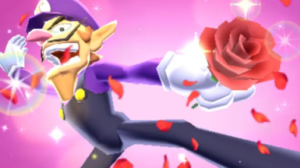

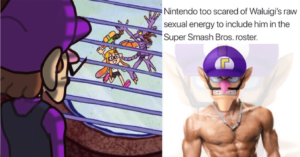
A mixture of repressed aggression and latent frustration in these failed flirtatious memes recalls the tacit depression of Rodger and others who might have experienced a similar tripartite of rejection, inferiority, and vicariousness. Despite his self-loathing of genetic makeup and social ranking, Rodger nonetheless considered himself as the supreme gentleman, in what could be a defensive ploy to circumvent nonacceptance. Nagle observes that this declaration “has remained a joke on the anti-feminist Internet ever since and Rodger has become a comical archetypal figure of the angry beta male.”[43] In this light, the supreme gentleman appears carnivalesque and the relationship, referring to Baudrillard, is fractal. The supreme gentleman is none other than Waluigi. It is no surprise then, that Waluigi’s head also appears superimposed in a meme as the brooding “Stupid, Sexy Waluigi,” a title referencing Homer’s frustration with his own body when seeing Ned Flanders in a ski suit (figure 7).
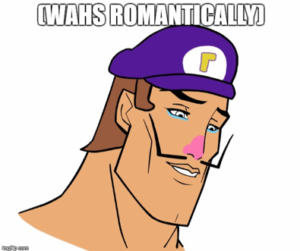
Others, as in the title of a subreddit by user mcgrathc09, ask the online community the question, “Why does no one care about our boy?”[44] Alpha or not, the malleable male body of Waluigi shapeshifts to accommodate these failed sensibilities that demonstrate the impulse to decidedly interrupt conventional representations of the alpha male, the societal norm, and the racer in first place.
The trajectory outlined in this paper points to the dawn of a countercultural figure. It has only scratched the surface of a comparative analysis of situating the meme of Waluigi as an alt-right influencer and the leader of Wahmunism. Uncovering this elusive group may point to a culturally incognito faction of radical enthusiasts fighting to keep an alternative and carnivalesque world spinning in an adoration of Waluigi. Such ironic veneration of this character has become so culturally powerful that Wahmunism stretches beyond its newly found political associations. For example, recent memes have already begun the apotheosis of Waluigi by juxtaposing him in a square with Jesus, the Buddha, and Shiva with the caption “What’s up with Gods holding their hands up?” (figure 8). Not surprisingly, Waluigi’s square has been swapped out with images of a saluting Hitler and Salt Bae. The religion of Wahmunism also emerges.
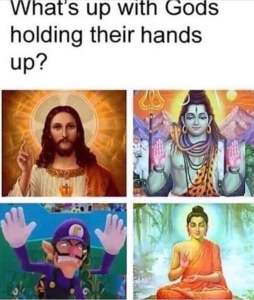
Nintendo has likely missed its window of opportunity to deter alt-light groups from incorporating Waluigi’s likeness as part of their political campaign. Further research would be required to determine whether the impact of these culturally profound memes is in fact, detrimental to Nintendo. Is there room for Nintendo to breathe new life back into Waluigi as the fourth player in a harmless game of tennis or in a heroic jaunt through Mushroom Kingdom? The quickest answer is no. Waluigi, drowning in a sea of memes and a void of representation, might not resuscitate from the subcultural myths or “dankness” that surrounds the avatar. As a symbol for the carnivalesque, a space of inverted political colouring and grotesque ideologies, Waluigi is on a polychromatic pathway (or Rainbow Road) to alt-right groups through the soft power of alt-light sensibility. It is on this pathway that Wahmunism can be accessed. Ready Player Four?
